Introduction
With a population projected to increase to 27.8 million by 2050, and the increased water requirements associated with that growth, many regions of Florida will face significant challenges meeting their water needs if changes are not made by multiple sectors. Because 50% or more of households’ water use is being directed toward outdoor uses such as lawn and landscape irrigation (DeOreo et al., 2016) as well as permanent in-ground irrigation systems in planned residential developments as a standard practice, developing strategies to reduce residential landscape water use are among the key objectives for researchers, policy makers, and conservation professionals. Irrigation restrictions are among the most common and cost-effective tools used to encourage water conservation (Boyer et al., 2018; Rajbhanary et al., 2010). For example, Boyer et al. (2018) reported irrigation demand decreases of 13% due to irrigation restrictions despite an increase in actual water needs during their study timeframe.
To elicit any best practice, such as following irrigation restrictions, practitioners must have a deep understanding of their audience’s perceptions, needs, and behaviors. Much of the water conservation research has heavily focused on conservation technologies, practices, and hardware (Dukes, 2020). The absence of behavior- and audience-specific social science research can prevent conservation initiatives from reaching their full potential (Warner, 2019). The information presented here is intended to inform water management district personnel, utility staff, public employees, and other educators and communicators who are charged with developing policies and strategies, promoting water use efficiency, and enforcing irrigation restrictions as a water conservation tool.
Approach
This information was drawn from a 2021 survey of Floridians’ water conservation practices and preferences, which is conducted annually by University of Florida Institute of Food and Agricultural Sciences faculty from the Department of Agricultural Education and Communication and Center for Land Use Efficiency. Target respondents were Florida residents 18 years and older using automated irrigation systems, who represent an important target audience for water conservation efforts. Purposive sampling with quota sampling was used (Lamm & Lamm, 2019) to ensure our sample was reflective of the Florida population according to US Census data (US Census Bureau, 2020).
Respondents
Out of a larger pool of survey respondents, 331 had a lawn or yard that they watered with an automated irrigation system and made decisions about. The following information is drawn from those 331 individuals. The average respondent age was 48 years old and the average Florida residence time was 24 years.
Six out of ten respondents indicated they lived in a homeowners association (HOA). The majority of those who lived in an HOA indicated their HOA had policies or requirements related to their landscape and could impose penalties related to the appearance of their landscape.
Irrigation Restriction Context
At the time of the study, all water management districts except for the Northwest Florida Water Management District (NWFWMD) had irrigation restrictions. Suwannee River Water Management District (SRWMD) and St. Johns River Water Management District (SJRWMD) had shifted to once-per-week restrictions (as of November 6th; SJRWMD, 2022; SRWMD, n.d.). South Florida Water Management District (SFWMD) and Southwest Florida Water Management District (SWFWMD) were on twice-per-week irrigation restrictions, although residents in some south Florida counties could water three days per week (SFWMD, n.d.) and some locations in southwest Florida were on once-per-week restrictions also (SWFWMD, 2018).
Findings
Respondents’ Awareness of Irrigation Restrictions
When we asked respondents from locations with irrigation restrictions in place if there were irrigation restrictions that influenced how they watered their yard, just under half of respondents who were under irrigation restrictions statewide (i.e., in all locations except NWFWMD) believed there were irrigation restrictions they had to follow. Just over half of the SFWMD and SJRWMD respondents believed they had irrigation restrictions, while 40% of those from SWFWMD and 30% from NWFWMD believed they had irrigation restrictions (even though that district has no restrictions). Note: due to a low number of respondents from this area, any comparisons by water management district (n = 329) exclude individuals from SRWMD.

Credit: UF/IFAS
Respondents believed they could water anywhere from one to seven days per week, with two being the most common answer.
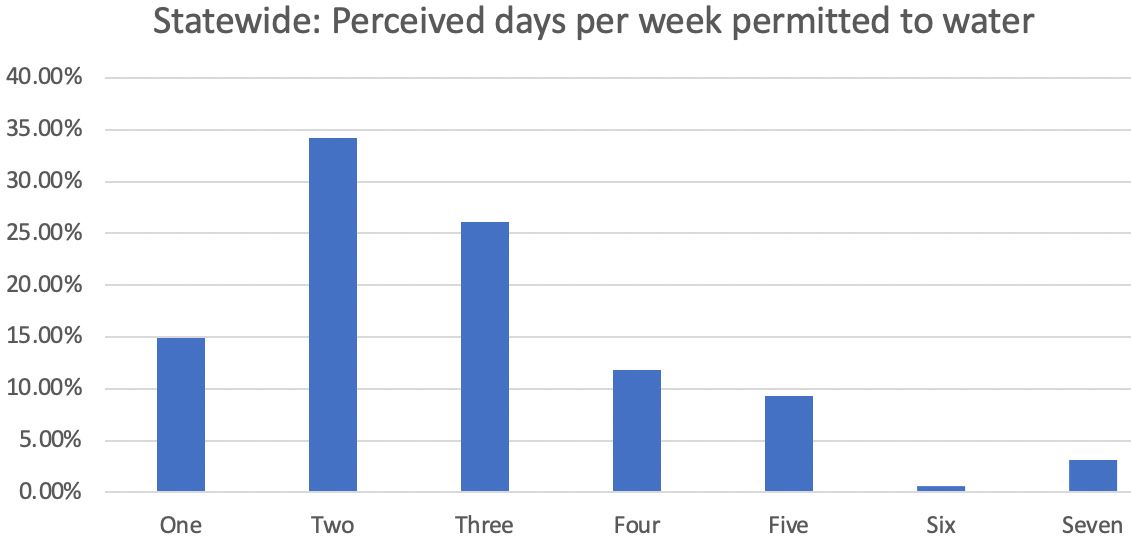
Credit: UF/IFAS
Two days per week was the most common response in SJRWMD, where only one day was actually permitted at the time of the survey. In NWFWMD two and four were tied as the most common response among those who believed there were irrigation restrictions in place.
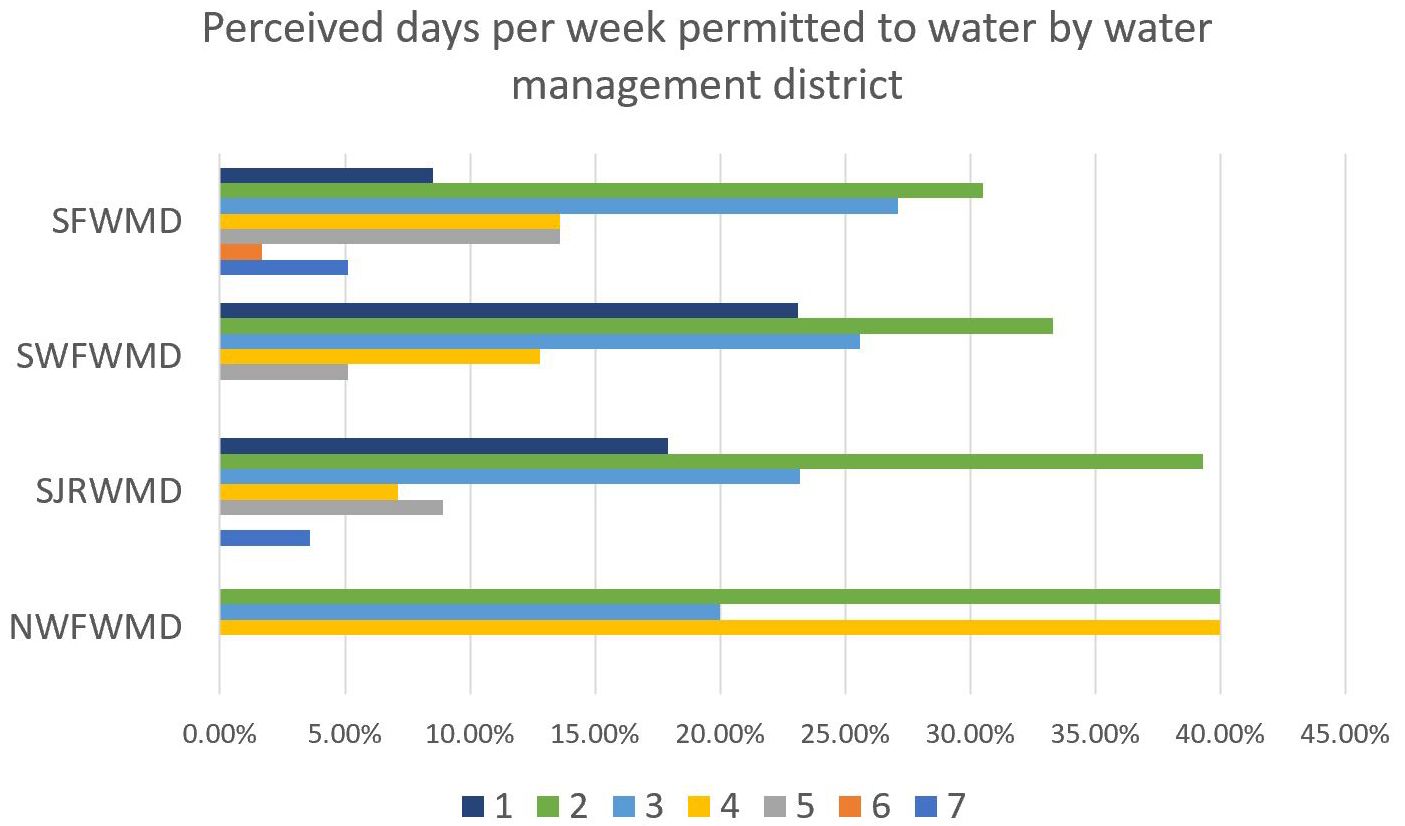
Credit: UF/IFAS
Respondents’ Information-Seeking Preferences Pertaining to Irrigation Restrictions
Overall, water management districts were the preferred source of information regarding irrigation restrictions. Environmental organizations and local UF/IFAS Extension offices were the least preferred.
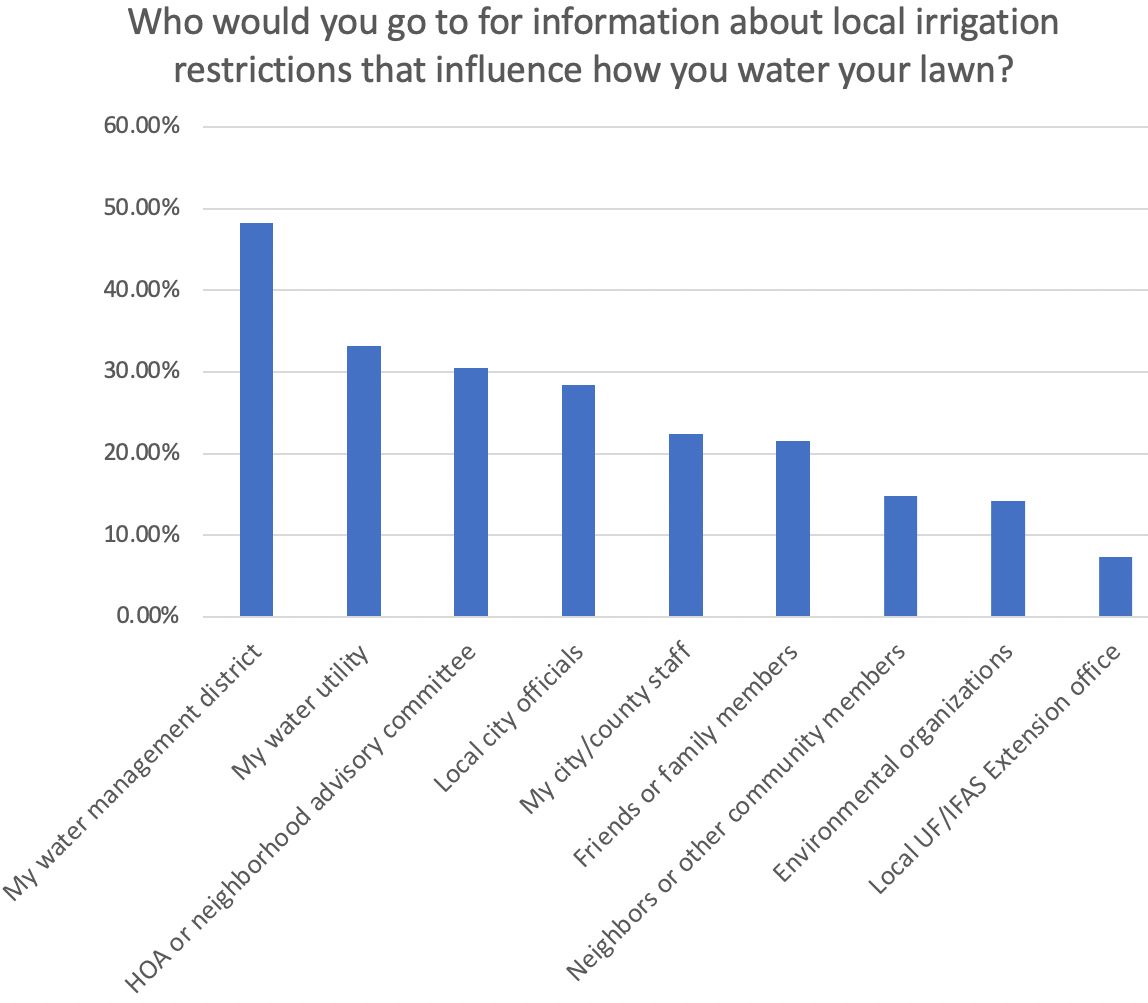
Credit: UF/IFAS
Respondents’ Awareness and Information-Seeking Preferences Pertaining to Irrigation Restrictions by Water Management District
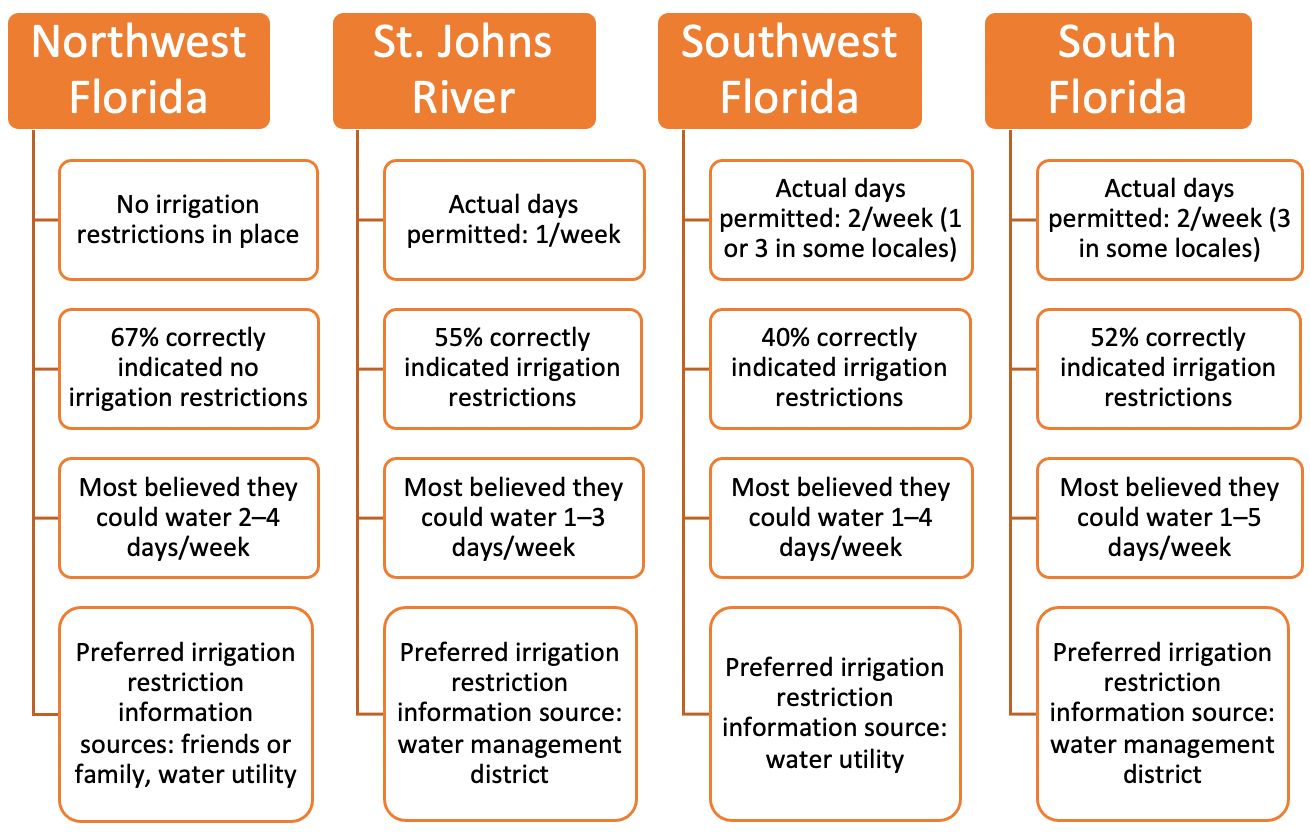
Credit: UF/IFAS
Factors That Relate to Being Aware of Irrigation Restrictions
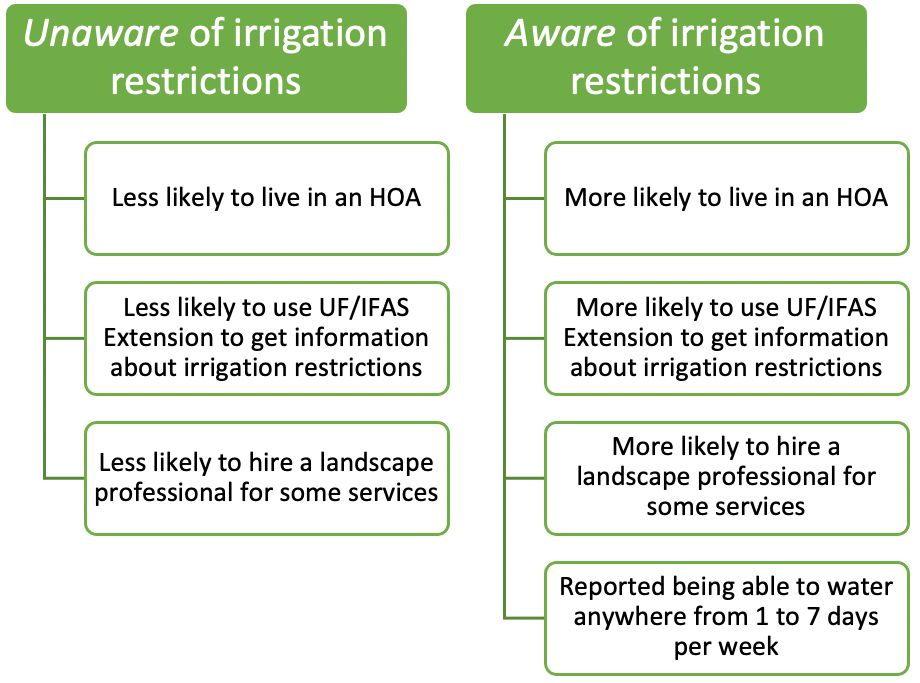
Credit: UF/IFAS
Willingness to Follow Irrigation Restrictions Relative to Other Residential Landscape Conservation Behaviors
Respondents were asked about likelihood of engaging in several landscape water conservation practices. Likelihood could range from -2 (very unlikely to engage in the practice) to +2 (very likely to engage in the practice), with 0 being neither unlikely nor likely. While average likelihood across all respondents was positive, likelihood of following irrigation restrictions was greater than all the other practices except for seasonally adjusting irrigation timing.
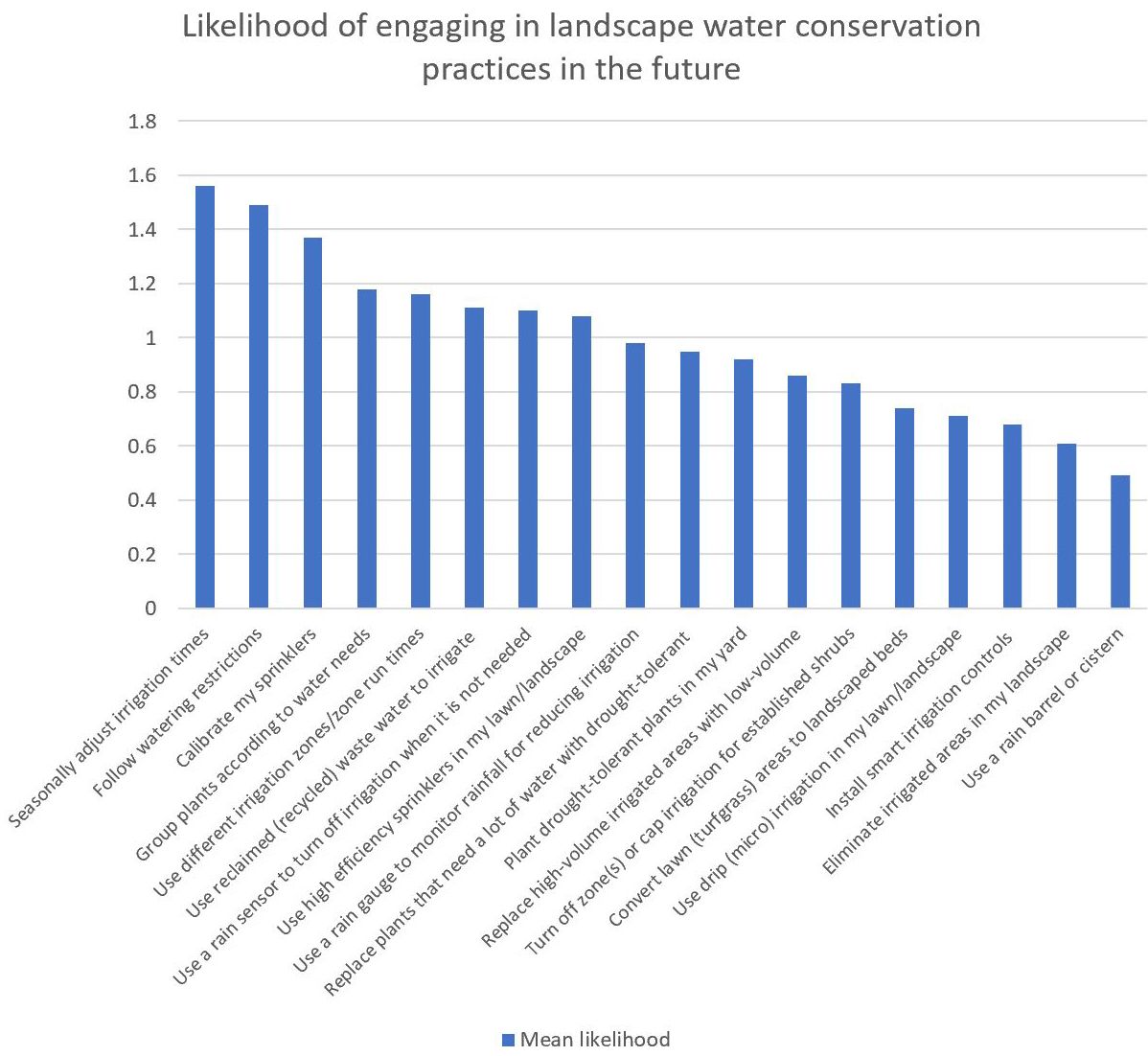
Credit: UF/IFAS
Note. Likelihood could range from -2 (very unlikely) to +2 (very likely).
Conclusions
This snapshot of citizens’ awareness and understanding of Florida’s irrigation restrictions revealed several key conclusions:
- One out of every ten respondents statewide is unsure whether there are irrigation restrictions that apply to them.
- Four out of every ten respondents from locations with irrigation restrictions in place believe there are no irrigation restrictions that apply to them.
- Many residents who use automated irrigation are also unaware of irrigation restrictions that apply to them, which highlights the importance of intentional, strategic education to ensure the success of irrigation restrictions as a conservation tool.
- Many of those that are aware of irrigation restrictions that apply to them are misinformed about the number of days per week they can water. Given that respondents were highly likely to follow irrigation restrictions, it appears that confusion or lack of understanding of these restrictions may be the barrier to following them rather than internal objection to the practice.
- There was a very low number of accurate respondents in terms of days per week permitted to water in locations where there had recently been a change to one day per week, implying there is a major challenge in educating to keep the public informed when restrictions are adjusted throughout the year.
- HOA dwellers who manage their own irrigation systems are more aware of irrigation restrictions than residents outside of HOAs who manage their irrigation systems, which points to the potential role HOAs play in educating Florida residents about this topic.
- Preferred information sources included water management districts, homeowners' associations or neighborhood advisory committees, and local city officials. It may be desirable to develop strategies to increase the usage of local city officials as an information source as most people also have local ordinances.
Suggestions for Applying This Information
Following the information presented here, water management district personnel, utility staff, public employees, and other educators and communicators who are charged with developing policies and promoting this type of water conservation tool should:
- Develop strategies to reach and raise awareness of the approximately half of automated irrigation users in locations with irrigation restrictions who do not know there are irrigation restrictions in place.
- Develop additional strategies to improve the accuracy in understanding the number of days per week residents are permitted to water.
- When restriction specifications change, dedicate resources to develop more visible strategies for increasing awareness of changes to irrigation restrictions (i.e., shifts from two days to one day per week).
- Ensure educational materials and messages are shared and coordinated with all information sources, and especially those preferred by respondents in the target area.
- Consider some of the preferred information sources, (e.g., city officials, HOAs) as key clientele for education on restrictions since residents are looking to these sources for information.
- Maintain and enhance partnerships with HOAs to deliver education about irrigation restrictions.
- Consider pairing these findings with information about Floridians’ preferred methods of learning about water conservation. For example, Floridians have reported they prefer more passive opportunities such as visiting a website, watching TV coverage, watching a video, and reading a fact sheet to learn about water conservation compared to more active learning such as attending workshops or conferences (Warner et al., 2020).
References
Boyer, M. J., Dukes, M. D., Duerr, I., & Bliznyuk, N. (2018). Water conservation benefits of long-term residential irrigation restrictions in Southwest Florida. JournalAWWA, 110(2), E2–E17. https://doi.org/10.5942/jawwa.2018.110.0019
DeOreo, W. B., Mayer, P. W., Dziegieleski, B., & Kiefer, J. C., 2016. Residential End Users of Water, Version 2 (Report #4309b). Water Research Foundation. Denver, Colorado.
Dukes, M. D. (2020). Two decades of smart irrigation controllers in USA landscape irrigation. Transactions of the ASABE, 63(5), 1593–1601. https://doi.org/10.13031/trans.13930
Lamm, A. J., & Lamm, K. W. (2019). The use of nonprobability sampling methods in agricultural and extension education research. Journal of International Agricultural and Extension Education, 26(1), 52–59. https://doi.org/10.5191/iaee.2019.26105. https://fycs.ifas.ufl.edu/swisher/00_6800_22_CNV/Non-Probability%20Sampling%20Methods%20in%20Ag_Lamm.pdf. Accessed February 15, 2023.
South Florida Water Management District [SFWMD]. (n.d.). Lawn watering restrictions. https://www.sfwmd.gov/community-residents/landscape-irrigation
Southwest Florida Water Management District [SWFWMD]. (2018). District water restrictions. https://www.swfwmd.state.fl.us/business/epermitting/district-water-restrictions
St. Johns River Water Management District [SJRWMD]. (2022). Watering restrictions. https://www.sjrwmd.com/wateringrestrictions/
Suwannee River Water Management District [SRWMD]. (n.d.). Year-round lawn & landscape irrigation measures. https://www.mysuwanneeriver.com/337/Lawn-Landscape-Irrigation-Measures
US Census Bureau. (2021). Quick Facts Florida. https://www.census.gov/quickfacts/FL (accessed December 10, 2021).
Warner, L. A. (2019). Using homeowners’ association membership to define audience segments for targeted local social marketing interventions: Implications from a statewide study. Social Marketing Quarterly, 25(4), 291–307. https://doi.org/10.1177/1524500419882978
Warner, L. A., Momol, E., Lewis, C., Wichman, T., Wilber, W., & Reisinger, A. J. (2020). Floridians’ engagement in landscape best practices to protect water resources: Information from a 2018 survey. EDIS, 2020(1). https://doi.org/10.32473/edis-wc345-2020